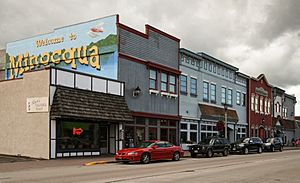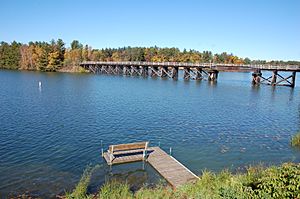Minocqua, Wisconsin facts for kids
Quick facts for kids
Minocqua, Wisconsin
Minwaakwaa
|
|
|---|---|

Downtown Minocqua
|
|
| Nickname(s):
The Island City
|
|
| Country | United States |
| State | Wisconsin |
| County | Oneida |
| Area | |
| • Total | 168.1 sq mi (435.3 km2) |
| • Land | 150.8 sq mi (390.6 km2) |
| • Water | 17.3 sq mi (44.8 km2) |
| Elevation | 1,598 ft (487 m) |
| Population
(2000)
|
|
| • Total | 4,859 |
| • Density | 32.2/sq mi (12.4/km2) |
| Time zone | UTC-6 (Central (CST)) |
| • Summer (DST) | UTC-5 (CDT) |
| Area code(s) | 715 & 534 |
| FIPS code | 55-53225 |
| GNIS feature ID | 1583727 |
Minocqua is a town in Wisconsin, United States. It's in Oneida County. In 2018, about 4,414 people lived there. The town is often called "The Island City." This is because part of it is on what used to be an actual island. The name Minocqua comes from the Ojibwe word "Ninocqua." It means "noon-day-rest."
Contents
History of Minocqua
Minocqua became an official town in 1889. It was first a logging town. This means people cut down trees for wood. The first child born in the town was Minocqua Clawson. A famous spot called Clawson Hill is now where the Pointe Resort & Hotel stands.
Railroads and Growth
Railroads were very important for Minocqua's early growth. The Milwaukee Road first came to get timber. Later, trains brought visitors and people who liked to hunt or fish. This helped Minocqua become a popular vacation spot. The old railroad bridges are still there. They are now part of the Bearskin State Trail. You can hike and bike on it in summer. In winter, it's used for snowmobiling.
Big Fire and Rebuilding
In 1912, a large fire destroyed many businesses downtown. After the fire, many new buildings were built. Today, the main street has many shops for tourists. But it also has a post office, banks, and restaurants. The center of Minocqua, called "The Island," has important buildings. These include the Campanile Center for the Arts and the police and fire departments. The Minocqua Community Center holds the town offices and public library.
Important Landmarks
Some well-known places on The Island are Torpy Park and the Belle-Isle building. The Minocqua Community Center is also a landmark. Bosacki's Boat House burned down in 1972. Even though rules usually stop rebuilding over water, people wanted it back. So, the DNR allowed it to be rebuilt.
Geography and Climate
Minocqua covers about 168 square miles (435 square kilometers). Most of this area is land, but about 17 square miles (44.8 square kilometers) is water. This means about 10% of the town is water.
The Island City
As mentioned, Minocqua is known as "The Island City." Part of the town is on what was once an island. You can reach it by a bridge on Highway 51. The soil in Minocqua is mostly sandy. Many areas are covered by forests. The highest point is Squirrel Hill. It is about 1,735 feet high.
Minocqua's Weather
Minocqua has a humid continental climate. This means it has long, cold winters. Summers are mild and humid.
| Climate data for Minocqua, Wisconsin, 1991–2020 normals, 1903-2020 extremes: 1601ft (488m) | |||||||||||||
|---|---|---|---|---|---|---|---|---|---|---|---|---|---|
| Month | Jan | Feb | Mar | Apr | May | Jun | Jul | Aug | Sep | Oct | Nov | Dec | Year |
| Record high °F (°C) | 56 (13) |
60 (16) |
78 (26) |
90 (32) |
99 (37) |
99 (37) |
106 (41) |
99 (37) |
95 (35) |
86 (30) |
75 (24) |
57 (14) |
106 (41) |
| Mean maximum °F (°C) | 38.3 (3.5) |
44.9 (7.2) |
57.3 (14.1) |
72.7 (22.6) |
82.7 (28.2) |
87.3 (30.7) |
87.8 (31.0) |
87.0 (30.6) |
82.4 (28.0) |
73.6 (23.1) |
56.4 (13.6) |
41.4 (5.2) |
90.1 (32.3) |
| Mean daily maximum °F (°C) | 19.7 (−6.8) |
25.1 (−3.8) |
36.8 (2.7) |
49.2 (9.6) |
63.8 (17.7) |
73.1 (22.8) |
76.7 (24.8) |
74.6 (23.7) |
66.5 (19.2) |
52.3 (11.3) |
36.6 (2.6) |
24.7 (−4.1) |
49.9 (10.0) |
| Daily mean °F (°C) | 10.5 (−11.9) |
14.0 (−10.0) |
24.7 (−4.1) |
37.4 (3.0) |
51.6 (10.9) |
61.9 (16.6) |
65.5 (18.6) |
63.2 (17.3) |
55.6 (13.1) |
42.9 (6.1) |
29.2 (−1.6) |
17.0 (−8.3) |
39.5 (4.1) |
| Mean daily minimum °F (°C) | 1.2 (−17.1) |
2.8 (−16.2) |
12.6 (−10.8) |
25.7 (−3.5) |
39.4 (4.1) |
50.8 (10.4) |
54.4 (12.4) |
51.7 (10.9) |
44.8 (7.1) |
33.5 (0.8) |
21.9 (−5.6) |
9.4 (−12.6) |
29.0 (−1.7) |
| Mean minimum °F (°C) | −22.2 (−30.1) |
−20.8 (−29.3) |
−12.9 (−24.9) |
9.8 (−12.3) |
25.6 (−3.6) |
35.3 (1.8) |
42.7 (5.9) |
40.1 (4.5) |
29.5 (−1.4) |
20.2 (−6.6) |
3.3 (−15.9) |
−14.9 (−26.1) |
−25.7 (−32.1) |
| Record low °F (°C) | −48 (−44) |
−48 (−44) |
−36 (−38) |
−18 (−28) |
15 (−9) |
25 (−4) |
30 (−1) |
30 (−1) |
19 (−7) |
3 (−16) |
−18 (−28) |
−36 (−38) |
−48 (−44) |
| Average precipitation inches (mm) | 1.27 (32) |
1.07 (27) |
1.72 (44) |
2.88 (73) |
3.76 (96) |
4.36 (111) |
4.10 (104) |
3.65 (93) |
3.56 (90) |
3.67 (93) |
2.08 (53) |
1.67 (42) |
33.79 (858) |
| Average snowfall inches (cm) | 20.40 (51.8) |
16.50 (41.9) |
16.90 (42.9) |
8.80 (22.4) |
0.70 (1.8) |
0.00 (0.00) |
0.00 (0.00) |
0.00 (0.00) |
0.00 (0.00) |
2.90 (7.4) |
12.80 (32.5) |
19.70 (50.0) |
98.7 (250.7) |
| Source 1: NOAA | |||||||||||||
| Source 2: XMACIS (records & monthly max/mins) | |||||||||||||
People of Minocqua
In 2010, about 4,385 people lived in Minocqua. They lived in about 2,079 homes. Many homes, about 2,493, are used only during certain seasons. Most people living in Minocqua are White (96.1%). There are also Native American (1.7%) and Asian (0.8%) residents. About 0.8% of the people are Hispanic or Latino. Many people in Minocqua are 65 or older (26.4%). About 16.3% are under 18. The average age is 51.6 years.
Fun Things to Do in Minocqua
Tourism is a big part of Minocqua's economy. Since it's a lake town with forests, there are many outdoor activities.
Summer Activities
In summer, you can enjoy:
- Fishing
- Camping
- Waterskiing
- Boating
- Hiking
- Bike riding
- Berry collecting
- Swimming
The downtown area, "The Island," has many shops and attractions for tourists. In summer, you can find bars with live music. Minocqua also has a big Fourth of July parade. This event includes dancing, music, fireworks, and a special water ski show.
Fall and Winter Fun
In the fall, hunting is popular. There's also an event called Beef-a-Rama in September. In winter, you can enjoy:
- Snowmobile festivals
- Cross-country skiing
- Ice fishing
- Downhill skiing (nearby)
- Snow tubing
- Sleigh rides
- Snowmobiling
Minocqua has a place called Minocqua Winter Park. It's great for cross-country skiing, sledding, and ice skating.
Min-Aqua Bats Water Ski Show
Minocqua is home to the Min-Aqua Bats. This is one of the oldest amateur water ski teams in the world. They have been performing shows at the Aqua Bowl for over 70 summers. They started regular shows in 1952.
Arts and Culture
The Campanile Center for the Arts is open all year. It brings many talented artists to Minocqua. It also offers classes in music, theater, and visual art.
Local Museums
The Minocqua Museum shows what Minocqua was like in its early days. You can also see a special U.S. flag at the American Legion Post. This flag was lowered by the last U.S. soldiers leaving the Vietnam War.
Education in Minocqua
Minocqua has a public elementary school called Minocqua-Hazelhurst-Lake Tomahawk Elementary School. There is also a private school, Trinity Lutheran School. For high school, students go to Lakeland Union High School.
Getting Around Minocqua
Bus service is available through Bay Area Rural Transit. The Lakeland Airport (KARV) is just 3 miles northwest of Minocqua's center. The Rhinelander-Oneida County Airport (KRHI) is about 25 miles away. It offers flights for both commercial and private planes. The old Milwaukee Road train line that went through town is now the Bearskin State Trail.
Images for kids
-
Bridge over Lake Minocqua in the Minocqua CDP
See also
 In Spanish: Minocqua (Wisconsin) para niños
In Spanish: Minocqua (Wisconsin) para niños











